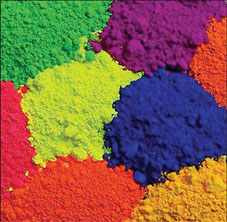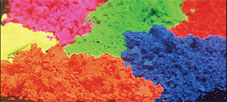A newly developed line of pigments no longer exhibits the common drawbacks.

Until now, colouring plastics with fluorescent pigments had been limited due to the high plate-out rate. Previous investigations showed that these pigments migrate to the surface of the moulded product during injection moulding (plate-out). The following processing difficulties arise as a result: ■ adhesion of the moulded articles to the mould surface, ■ interruption of production, ■ poor quality of the moulded part''s surface, ■ the need for solvents to clean the mould surface, and ■ difficulties when printing on the injection moulded articles. To minimise these drawbacks when using fluorescent pigments, Radiant Color N.V., Houthalen/Belgium, introduced the RadGlo EA line of pigments 15 year ago. The newly developed RadGlo RPC Series of pigments offers additional improvements. Plate-out reduced, heat stability increased The occurrence of plate-out when processing the RadGlo EA and RPC lines of pigment was investigated by injection moulding 300 chips (articles) with a pigment loading of 2% each (normal concentration is 0,75 to 1%). Once injection moulding had been completed, the surface of the mould was examined for plate-out. Both the degree of coverage and the plate-out density were assigned a rating from 0 (no plate-out) to 5 (heavy plate-out). Under the test conditions, the RadGlo EA pigment produced significant plate-out. This increased from a rating of 2 after 100 injection moulded chips to a rating of 5 after 300 injection moulded chips. Testing of the RadGlo RPC series produced no plate-out on the mould surface, even after the last chip. Similar results were obtained when extruding film. Even after 8 hours of continuous blow moulding production (1% RadGlo RPC10 in PE-HD) there was no increase in weight of the blow pin and no plate-out on the mould surface. When comparing the heat stability of both families of fluorescent pigments, monitoring of 3 mm thick PE-HD chips coloured with 1% RadGlo EA10 showed a 15% reduction in stability with respect to maximum reflection between 220 and 280癈, while similar chips coloured with 1% RadGlo RPC10 exhibited stable maximum reflection.

Improved characteristics Newly developed fluorescent pigments in the RadGlo RPC Series exhibit the following characteristics: ■ no plate-out during injection moulding or when producing blow film, ■ improved heat stability, especially at lower pigment loadings, ■ high reflection in daylight and under UV light (black light), ■ high compatibility with PE-HD, PE-LD, PE-LLD, PP, clarified PP and TPU, ■ very good printability of coloured items: inks withstand the tape test (stick an adhesive tape on the printed item and then remove the tape with out picking up the ink), and ■ no need for high shear forces to develop optimal colour strength and shade. Using this technology, it is possible to achieve all available colour shades in polyolefins. Moreover, the RadGlo RPC Series functions as a compatibiliser, permitting use of UV absorbers or heat stabiliser and other additives in polyolefins. The RadGlo SATK Series utilises the same technology as the RadGlo RPC Series. This series offers brilliant, strongly saturated shades of yellow red and magenta. All SATK pigments are 100% compatible with the RPC and EA Series. Thus, designers can obtain all intermediate shades from highly fluorescent (RPC) to brilliant and saturated (SATK).
Nike Odyssey React Until now, colouring plastics with fluorescent pigments had been limited due to the high plate-out rate. Previous investigations showed that these pigments migrate to the surface of the moulded product during injection moulding (plate-out). The following processing difficulties arise as a result: ■ adhesion of the moulded articles to the mould surface, ■ interruption of production, ■ poor quality of the moulded part''s surface, ■ the need for solvents to clean the mould surface, and ■ difficulties when printing on the injection moulded articles. To minimise these drawbacks when using fluorescent pigments, Radiant Color N.V., Houthalen/Belgium, introduced the RadGlo EA line of pigments 15 year ago. The newly developed RadGlo RPC Series of pigments offers additional improvements. Plate-out reduced, heat stability increased The occurrence of plate-out when processing the RadGlo EA and RPC lines of pigment was investigated by injection moulding 300 chips (articles) with a pigment loading of 2% each (normal concentration is 0,75 to 1%). Once injection moulding had been completed, the surface of the mould was examined for plate-out. Both the degree of coverage and the plate-out density were assigned a rating from 0 (no plate-out) to 5 (heavy plate-out). Under the test conditions, the RadGlo EA pigment produced significant plate-out. This increased from a rating of 2 after 100 injection moulded chips to a rating of 5 after 300 injection moulded chips. Testing of the RadGlo RPC series produced no plate-out on the mould surface, even after the last chip. Similar results were obtained when extruding film. Even after 8 hours of continuous blow moulding production (1% RadGlo RPC10 in PE-HD) there was no increase in weight of the blow pin and no plate-out on the mould surface. When comparing the heat stability of both families of fluorescent pigments, monitoring of 3 mm thick PE-HD chips coloured with 1% RadGlo EA10 showed a 15% reduction in stability with respect to maximum reflection between 220 and 280癈, while similar chips coloured with 1% RadGlo RPC10 exhibited stable maximum reflection.
Until now, colouring plastics with fluorescent pigments had been limited due to the high plate-out rate. Previous investigations showed that these pigments migrate to the surface of the moulded product during injection moulding (plate-out). The following processing difficulties arise as a result: ■ adhesion of the moulded articles to the mould surface, ■ interruption of production, ■ poor quality of the moulded part''s surface, ■ the need for solvents to clean the mould surface, and ■ difficulties when printing on the injection moulded articles. To minimise these drawbacks when using fluorescent pigments, Radiant Color N.V., Houthalen/Belgium, introduced the RadGlo EA line of pigments 15 year ago. The newly developed RadGlo RPC Series of pigments offers additional improvements. Plate-out reduced, heat stability increased The occurrence of plate-out when processing the RadGlo EA and RPC lines of pigment was investigated by injection moulding 300 chips (articles) with a pigment loading of 2% each (normal concentration is 0,75 to 1%). Once injection moulding had been completed, the surface of the mould was examined for plate-out. Both the degree of coverage and the plate-out density were assigned a rating from 0 (no plate-out) to 5 (heavy plate-out). Under the test conditions, the RadGlo EA pigment produced significant plate-out. This increased from a rating of 2 after 100 injection moulded chips to a rating of 5 after 300 injection moulded chips. Testing of the RadGlo RPC series produced no plate-out on the mould surface, even after the last chip. Similar results were obtained when extruding film. Even after 8 hours of continuous blow moulding production (1% RadGlo RPC10 in PE-HD) there was no increase in weight of the blow pin and no plate-out on the mould surface. When comparing the heat stability of both families of fluorescent pigments, monitoring of 3 mm thick PE-HD chips coloured with 1% RadGlo EA10 showed a 15% reduction in stability with respect to maximum reflection between 220 and 280癈, while similar chips coloured with 1% RadGlo RPC10 exhibited stable maximum reflection.  Improved characteristics Newly developed fluorescent pigments in the RadGlo RPC Series exhibit the following characteristics: ■ no plate-out during injection moulding or when producing blow film, ■ improved heat stability, especially at lower pigment loadings, ■ high reflection in daylight and under UV light (black light), ■ high compatibility with PE-HD, PE-LD, PE-LLD, PP, clarified PP and TPU, ■ very good printability of coloured items: inks withstand the tape test (stick an adhesive tape on the printed item and then remove the tape with out picking up the ink), and ■ no need for high shear forces to develop optimal colour strength and shade. Using this technology, it is possible to achieve all available colour shades in polyolefins. Moreover, the RadGlo RPC Series functions as a compatibiliser, permitting use of UV absorbers or heat stabiliser and other additives in polyolefins. The RadGlo SATK Series utilises the same technology as the RadGlo RPC Series. This series offers brilliant, strongly saturated shades of yellow red and magenta. All SATK pigments are 100% compatible with the RPC and EA Series. Thus, designers can obtain all intermediate shades from highly fluorescent (RPC) to brilliant and saturated (SATK).Nike Odyssey React
Improved characteristics Newly developed fluorescent pigments in the RadGlo RPC Series exhibit the following characteristics: ■ no plate-out during injection moulding or when producing blow film, ■ improved heat stability, especially at lower pigment loadings, ■ high reflection in daylight and under UV light (black light), ■ high compatibility with PE-HD, PE-LD, PE-LLD, PP, clarified PP and TPU, ■ very good printability of coloured items: inks withstand the tape test (stick an adhesive tape on the printed item and then remove the tape with out picking up the ink), and ■ no need for high shear forces to develop optimal colour strength and shade. Using this technology, it is possible to achieve all available colour shades in polyolefins. Moreover, the RadGlo RPC Series functions as a compatibiliser, permitting use of UV absorbers or heat stabiliser and other additives in polyolefins. The RadGlo SATK Series utilises the same technology as the RadGlo RPC Series. This series offers brilliant, strongly saturated shades of yellow red and magenta. All SATK pigments are 100% compatible with the RPC and EA Series. Thus, designers can obtain all intermediate shades from highly fluorescent (RPC) to brilliant and saturated (SATK).Nike Odyssey React













